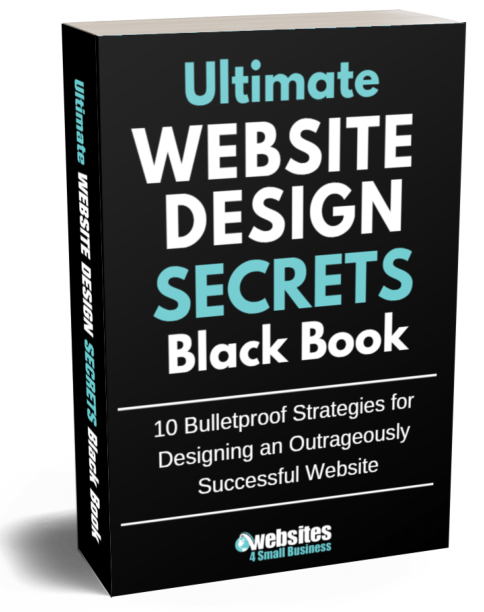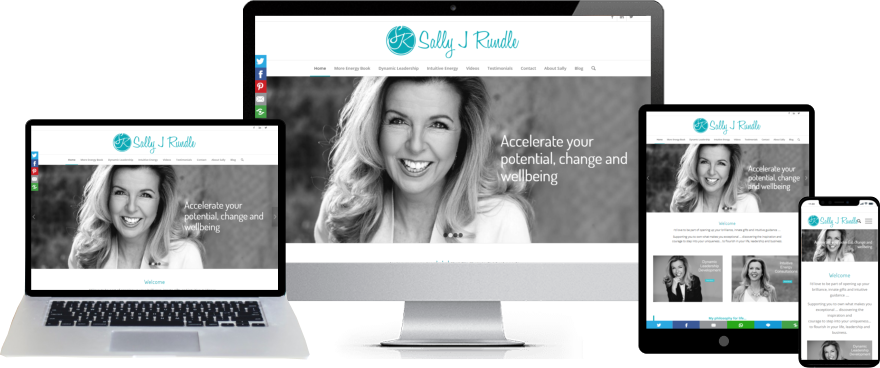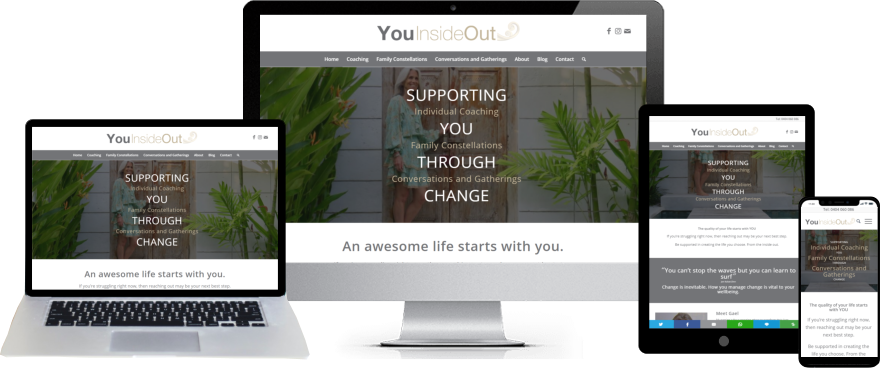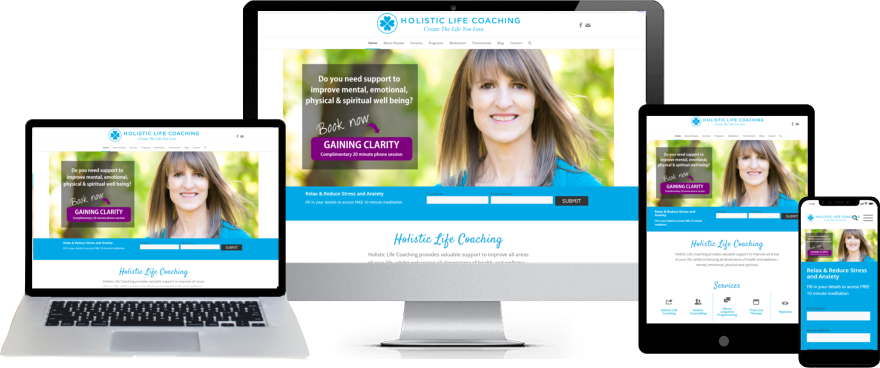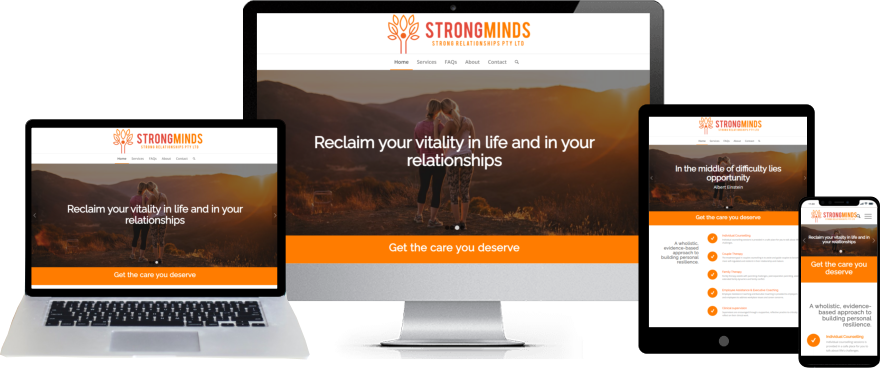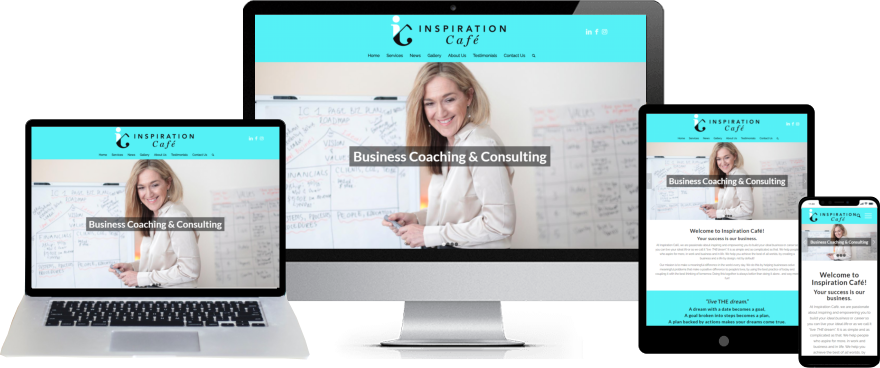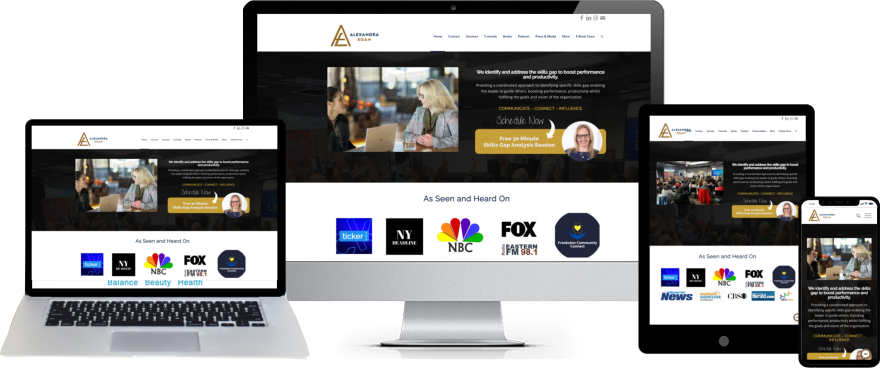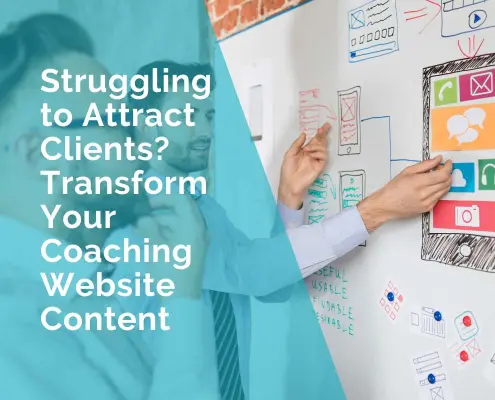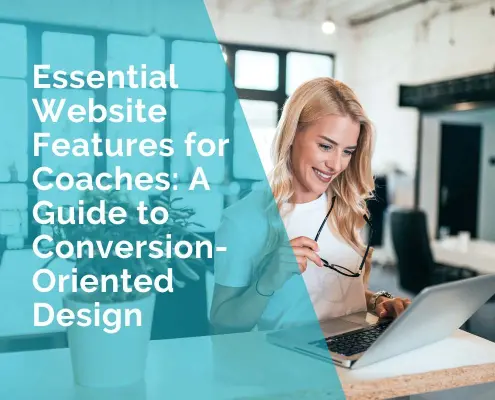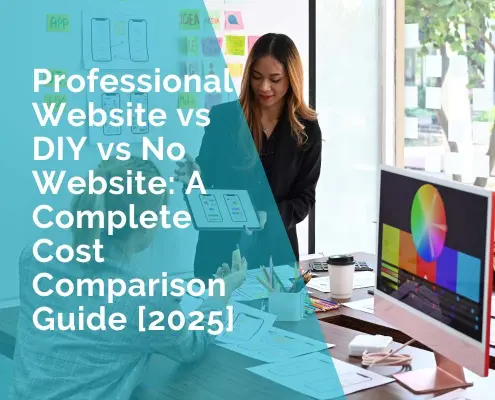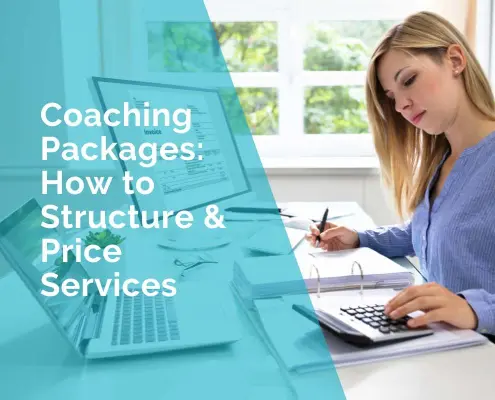Complete Guide to Coaching Websites: Everything You Need to Know [2025]
Last Updated: November 2024
Reading Time: 12 minutes
Your coaching website isn’t just a digital business card—it’s the cornerstone of your practice’s growth and success. Potential clients are making split-second decisions about whether to work with you based solely on your online presence. The difference between a website that converts visitors into clients and one that sends them clicking away often comes down to strategic design and implementation choices.
The last 5-8 years has seen an increase of people starting their own coaching or consulting business. Many are ex corporate executives who decide to take charge of their future and become their own bosses.
There are many types of coaches:
- Business coaches
- Finance coaches
- Sales coaches
- Life / personal coaches
- Health and wellness coaches
- Fitness coaches
- Family coaches
- Spiritual coaches
- Career coaches
- Web design coaches
And also consultants
- Management consultants
- Human resource consultants
- IT consultants
- Strategy consultants
- Financial consultants
- Risk & compliance consultants
- Marketing consultants
- Image consultants
- PR consultants
- Social media consultants
Do I Really Need a Website?
The simple answer is YES, definitely! Even if you have a social media profile such as LinkedIn, your website should be the centre of your business universe. You have no control over what happens with social networks, whereas you do with your website.
For example, look at what happened with Google Plus – over 200 million users and it got shut down. MySpace used to be the place to hang out, until Facebook came along. If your business mainly depended on either of these platforms, you would have been in a lot of trouble.
Your website should connect your marketing and lead-generation efforts and help you build credibility with your audience. It allows you to form long- term connections and to tell your story.
It saves you time and works for you 24/7 – potential clients and key decision makers can find out more information about you, even when you are asleep.
There are so many reasons to have a website – some of these include
- Central hub for information about your business
- Lets you sell products, courses and services 24/7
- Answers potential customer’s questions
- Provides leads different ways to contact you
- Links to your social networks, podcasts and videos
- Lets you accept bookings for workshops, speaking engagement, seminars, classes
- Provides opportunity to showcase your portfolio
- Can be a library of resources, articles, downloadables and links
- Gives you opportunity to interact with customers in real time
- Set up a sales funnel and landing pages
- Collect customer emails and phone numbers
- Offer special deals and promotions
- Reach customers around the world
- Lets you share your story
➤ Key Takeaways:
- A professional coaching website can increase client conversion rates by up to 30%
- 83% of potential clients research coaches online before making contact
- Your website needs to accomplish 5 key goals (detailed below)
- The right website structure can automate 40% of your client acquisition process
Understanding Your Coaching Website Needs
Before diving into the technical aspects of creating your coaching website, it’s crucial to understand exactly what your website needs to accomplish. Let’s break down the five essential goals your coaching website must achieve:
1. Attract Your Ideal Clients
Your website should act as a magnet for your perfect-fit clients. This means:
- Speaking directly to their challenges and aspirations
- Positioning your unique coaching approach
- Showcasing relevant expertise and results
- Creating content that resonates with their needs
Pro Tip: Your website should answer these three questions within 5 seconds:
- Who do you help?
- How do you help them?
- Why should they choose you?
2. Build Instant Credibility
In the coaching industry, trust is everything. Your website needs to establish credibility through:
- Professional design that reflects your expertise
- Clear demonstration of results and impact
- Social proof from past clients
- Relevant certifications and credentials
Real World Example: Sarah, a leadership coach, increased her consultation bookings by 45% after adding a “Client Success Stories” section to her homepage, featuring specific results and metrics from past clients.
3. Streamline Your Operations
Your website should work as your 24/7 business partner by:
- Automating client bookings and payments
- Qualifying prospects through strategic content
- Delivering lead magnets and nurture sequences
- Managing client communications efficiently
Common Mistake: Many coaches focus solely on design aesthetics while overlooking operational functionality. Your website should reduce your administrative workload, not add to it.
4. Convert Visitors into Clients
Every element of your website should guide visitors toward becoming clients:
- Clear, compelling calls-to-action
- Streamlined booking process
- Strategic content placement
- Effective lead capture systems
Case Study: “After restructuring my website’s conversion path, my discovery call bookings increased from 3 to 12 per week, with a higher percentage of qualified leads.”
Michael R., Business Coach
5. Scale Your Practice
Your website should support your growth by:
- Establishing thought leadership through content
- Supporting multiple revenue streams
- Automating client onboarding
- Facilitating group programs and courses
Essential Pages: The Foundation of Your Coaching Website
Every successful coaching website needs these five core pages:
Homepage
Your homepage should immediately answer three questions:
- Who do you help?
- What transformation do you offer?
- Why should they choose you?
Key Elements:
- Clear headline stating your value proposition
- Professional photo or video of you in action
- Client success stories and testimonials
- Primary call-to-action (usually booking a call)
- Preview of your services
- Trust indicators (certifications, media features, results)
Example Headline: “Help High-Performing Leaders Scale Their Impact While Working Less” Instead of: “Welcome to My Coaching Website”
About Page
Your about page should build connection and credibility:
- Your professional journey and expertise
- Relevant experience and credentials
- Client success stories
- Your unique coaching approach
- Clear next steps for potential clients
Learn more – How to Write a Coaching Bio that Sells
Services Page
Present your offerings clearly:
- Package descriptions with clear outcomes
- Pricing strategy (if public)
- Client success stories
- Frequently asked questions
- Multiple calls-to-action
- Clear booking process
Results/Case Studies
Demonstrate your impact:
- Specific client transformations
- Measurable results
- Timeline of changes
- Client testimonials
- Industry-specific outcomes
Contact/Booking
Make it easy to take the next step:
- Simple contact form
- Calendar booking system
- Clear response times
- FAQ section
- Multiple contact options
Key Design Elements: Creating a Professional Image
Your website’s design isn’t just about aesthetics—it’s about building trust and guiding potential clients toward working with you.
Professional Branding
Choose elements that reflect your coaching style:
Colours:
- Primary: Deep blue or navy (trust, professionalism)
- Secondary: Warm grey (sophistication)
- Accent: Gold or teal (premium, action)
- White space (clarity, professionalism)
Typography:
- Headlines: Clean, modern fonts (like Playfair Display)
- Body text: Highly readable fonts (like Open Sans)
- Minimum 16px font size for readability
- Consistent spacing and hierarchy
Mobile Optimization
With over 60% of visitors using mobile devices:
- Touch-friendly buttons (minimum 44×44 pixels)
- Easy-to-read text without zooming
- Simplified menus
- Quick-loading images
- Easy form completion
- Click-to-call functionality
Trust Indicators
Place these elements strategically:
- Client testimonials with photos
- Industry certifications
- Media appearances
- Professional memberships
- Security badges
- Privacy assurances
Clear Calls-to-Action
Guide visitors to take action:
- One primary CTA per page
- Contrasting button colors
- Action-oriented text
- Clear value proposition
- Strategic placement
- Mobile-friendly sizing
Pro Tip: Your website design should match your coaching style and price point. Premium coaching services need premium design elements.
Learn more about calls to action
➤ Key Takeaways:
- Professional design builds immediate trust
- Mobile optimisation is non-negotiable
- Consistent branding reflects your expertise
- Strategic CTAs guide visitor actions
Must-Have Features: Essential Tools for Your Coaching Website
Your coaching website needs specific features to effectively convert visitors into clients and streamline your business operations.
Booking System Integration
Choose a professional scheduling system that:
- Syncs with your calendar
- Handles time zones automatically
- Sends automated reminders
- Allows buffer time between sessions
- Integrates with your CRM
- Processes payments seamlessly
Popular options include Calendly, Acuity, or SimplyBook.me
Lead Generation Tools
Capture and nurture potential clients:
- Strategic pop-ups (exit-intent, timed)
- Landing page templates
- Lead magnet delivery system
- Newsletter integration
- Contact form automation
- Thank you page optimisation
Payment Processing
Secure payment options including:
- Credit card processing
- Payment plans
- Subscription handling
- Invoice generation
- Receipt automation
- Multiple currency support
Email Marketing Integration
Automate your client communications:
- Welcome sequences
- Nurture campaigns
- Booking confirmations
- Session reminders
- Follow-up emails
- Newsletter management
Analytics and Tracking
Monitor your website’s performance:
- Goal tracking
- Conversion monitoring
- User behaviour analysis
- Heat mapping
- Form analytics
- ROI measurement
➤ Key Takeaways:
- Automated booking saves hours of admin time
- Lead capture tools grow your client base
- Professional payment systems build trust
- Email automation nurtures prospects
- Analytics guide improvement decisions
Technical Foundation: Building a Reliable Coaching Website
A strong technical foundation ensures your website performs reliably and securely, creating a professional experience for your clients.
Platform Selection
WordPress advantages for coaches:
- Easy content management
- Extensive plugin options
- Regular security updates
- SEO-friendly structure
- Mobile responsiveness
- Custom functionality
Essential Security
Protect your website and client data:
- SSL certificate (https://)
- Regular backups
- Malware scanning
- Firewall protection
- Strong passwords
- User access control
Speed Optimisation
Keep your website loading quickly:
- Image compression
- Caching setup
- Code minification
- CDN integration
- Database optimisation
- Plugin management
Hosting Requirements
Choose reliable hosting that offers:
- Australian servers
- 99.9% uptime
- Daily backups
- Security features
- Technical support
- Scalability options
Integration Capabilities
Connect essential business tools:
- CRM systems
- Email marketing
- Payment gateways
- Booking systems
- Analytics tools
- Social media
Pro Tip: Invest in quality hosting and security from the start—it’s more cost-effective than fixing issues later.
Common Mistake: Installing too many plugins can slow down your site and create security vulnerabilities.
➤ Key Takeaways:
- WordPress offers the best balance of features and control
- Security measures protect your business and clients
- Speed optimisation impacts user experience and SEO
- Quality hosting provides peace of mind
- Proper integrations streamline operations
SEO Basics: Attracting Your Ideal Coaching Clients
Effective SEO helps your ideal clients find your coaching website when searching for solutions you provide.
Local SEO Focus
Optimise for Australian searches:
- Google Business Profile setup
- Local business citations
- Australian business directories
- Location-specific content
- Regional targeting
- Local testimonials
Keyword Strategy
Focus on terms your ideal clients use:
- Location-based keywords: Business coach Sydney, Executive coach Melbourne, Leadership coach Brisbane
- Service-based keywords: Business coaching programs, Executive leadership development, Team performance coaching
- Problem-solution keywords: How to scale my business, Improve team performance, Leadership development strategy
Content Optimisation
Create content that ranks and converts:
- Descriptive page titles
- Compelling meta descriptions
- Strategic heading usage
- Internal linking structure
- Image optimisation
- Mobile-friendly formatting
Technical SEO Elements
Ensure search engines can find and index your content:
- Site structure
- XML sitemap
- Robots.txt file
- Schema markup
- Loading speed
Pro Tip: Focus on creating valuable content that answers your ideal clients’ specific questions rather than trying to rank for broad, competitive terms.
Common Mistake: Targeting overly competitive keywords instead of focusing on specific, niche terms that your ideal clients actually use.
➤ Key Takeaways:
- Local SEO is crucial for Australian coaches
- Target keywords based on client intent
- Quality content drives organic traffic
- Technical SEO supports visibility
- Regular updates improve rankings
Evolution of Coaching Websites: 2020-2025
2020: Basic Digital Presence
- ✓ Basic WordPress websites
- ✓ Simple contact forms
- ✓ Standard blog posts
- ✓ Manual booking processes
- ✓ Basic mobile responsiveness
2021: Enhanced Communication
- ✓ Zoom integration
- ✓ Basic online scheduling
- ✓ PDF resource downloads
- ✓ Newsletter integration
- ✓ Simple payment processing
2022: Client Experience Focus
- ✓ Basic client portals
- ✓ Automated scheduling systems
- ✓ Video testimonials
- ✓ Basic CRM integration
- ✓ Improved mobile experience
2023: Automation & Integration
- ✓ Basic AI chat support
- ✓ Interactive calendars
- ✓ Automated email sequences
- ✓ Digital contract signing
- ✓ Enhanced security measures
2024: Advanced Functionality
- ✓ Advanced AI chatbots
- ✓ Comprehensive client portals
- ✓ Progress tracking tools
- ✓ Subscription management
- ✓ Multi-platform integration
2025: Intelligent Coaching Platforms
- ✓ Personalised AI coaching assistants
- ✓ Virtual reality session options
- ✓ Advanced analytics and insights
- ✓ Automated progress tracking
- ✓ Integrated coaching ecosystems
Step by Step Guide to Creating a Coaching Website
Here are 15 steps to setting up a successful coaching and consulting website
1. Decide on your business name
For most coaches and consultants it makes sense to set up a personal brand and trade under your own name. However, if you are setting up a partnership or a company, then you might want to consider a business name. For example if you are setting up a business coaching website, you could consider names such as these, providing they are still available:
- Catalyst Coaching
- Thrive Consulting
- Success Mentors
- Momentum Coaching
- Rise Up Coaching
- Empower Business Coaching
- Visionary Consulting
- Growth Mindset Coaching
- Flourish Business Coaching
- Ascend Consulting
Discover how to find the perfect name for your business.
2. Register your domain name
If you are trading under your name, then simply register that, eg. JennySmith.com (for a global brand) or JennySmith.com.au if the majority of your clients are based in Australia.
Since we are at over 1.8 billion websites, you may find that your preferred domain name is taken.
Here are some tips to find the perfect domain name for your business.
3. Decide what software to use for your website
You have a lot of choices when it comes to website design platforms – WordPress, Squarespace, Wix, Jimdo, etc.
WordPress is the most popular tool because it is:
- Flexible and adaptable – it allows you to easily add functionality through the use of plugins
- User friendly – if you select the right theme
- Search engine friendly and can help you rank high
- Mobile responsive
- Supported by WordPress community
4. Select a WordPress theme
WordPress theme is a tool that helps you create your website without knowing how to code. There are thousands of free and paid themes and I would strongly recommend using a paid theme as it gets regularly updated by the developers.
If you choose a free theme, you may find it stops working after a while, as the developers have no incentive to keep updating it since they are not getting paid.
Two great themes to check out are Enfold WordPress Theme and Divi Theme.
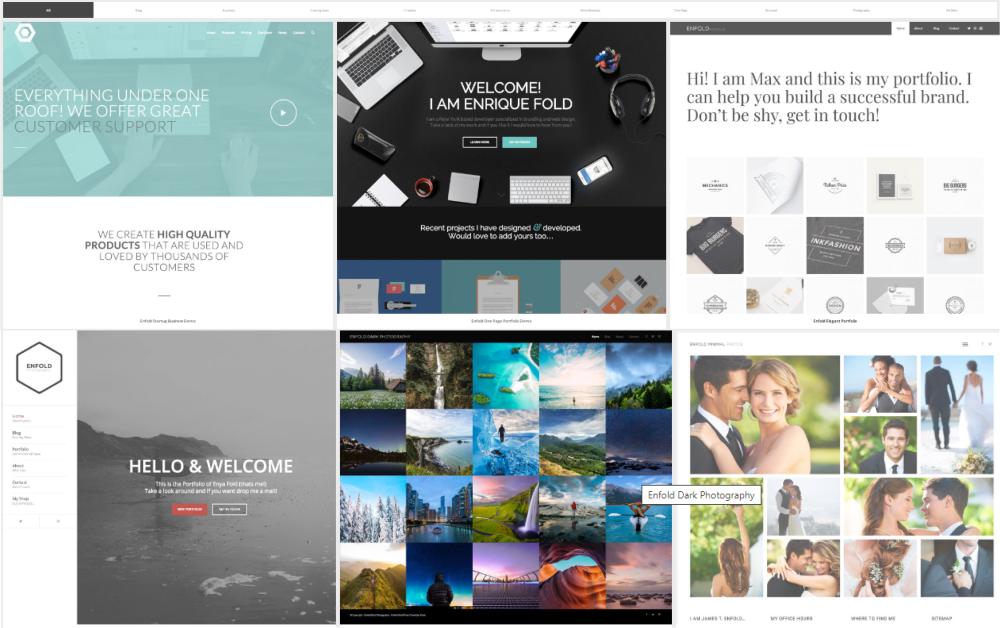
5. Decide whether to create the website yourself or get someone to do it.
You have several options.
- Do it yourself
- Get a developer from India / Philippines to design the website for you
- Hire a local website designer
If you decide to create the website yourself, you may need to spend weeks / months learning about website design, webhosting, integrations, search engine optimisation etc. This will slow down your progress your business set up.
The advantage is that you will have complete creative control and may save some money.
If you hire a developer from overseas, you may save some money, however, you may find that they have different cultural and work ethics, there may be a language barrier, time differences can be an issue and they don’t often have local market knowledge.
For most coaches and consultants I would recommend hiring a local web developer. It may initially cost you a little more, but the advantages are:
- They have knowledge of the local market
- Understand website design trends and security
- Can develop more advanced websites with shopping carts and various automations
- Can help with website marketing and search engine optimisation
- They can troubleshoot and fix up problems and help with updates and upgrades
In order to create your website, your developer will need various details about your business and products / services.
Here is a link to Website Design Brief to help you put the details together
6. Choose a webhosting company
If you are designing the website yourself, you will need to choose your own webhosting company. I highly recommend using SiteGround – they have affordable hosting plans and exceptional technical support.
7. Design your logo
Your logo is the cornerstone of your brand, so make sure your logo is designed by a professional graphic designer.
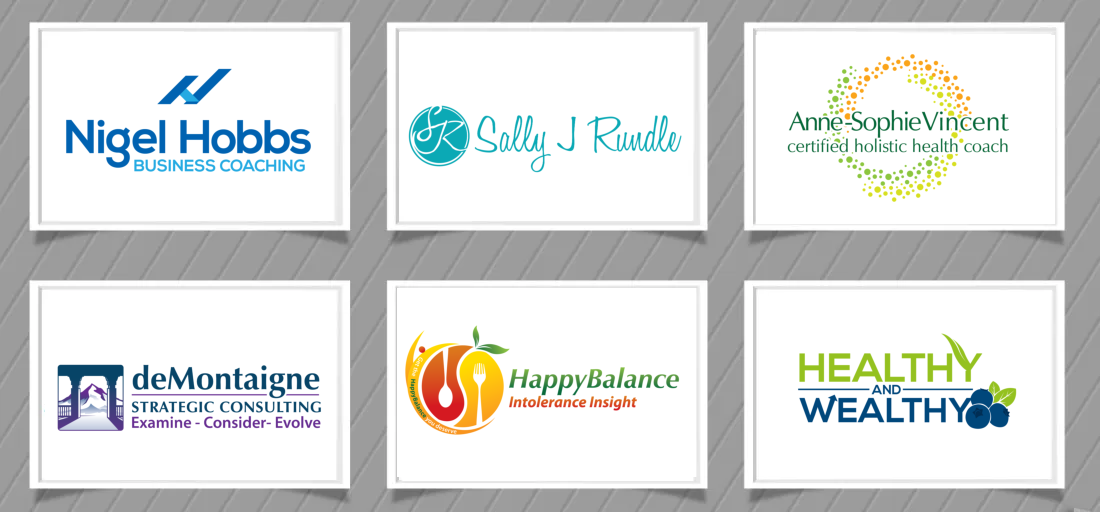
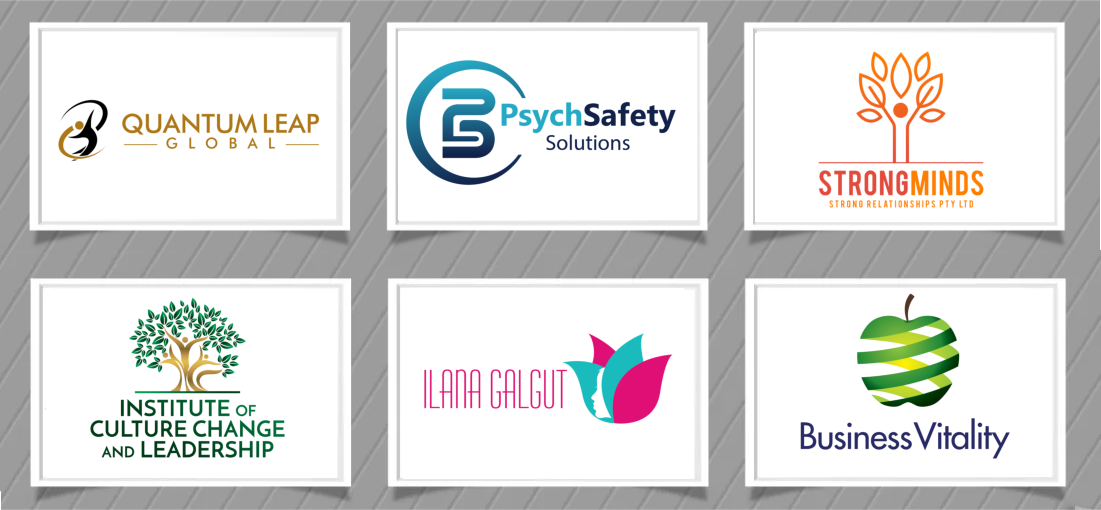
8. Craft a tag line
When someone arrives at your website, they need to know within 7 seconds that you can help them resolve their problems. A good tagline does that – it encourages people to read more about your business and what you can offer.
Here are some ideas for coaching / consulting taglines:
- It’s time to clarify your direction
- A journey that begins with self discovery
- Stop feeling lost and let’s set your path together
- Moving forward is a state of mind
- Every journey starts with a first step
- From strategy to delivery, on time every time
- Accelerating your growth
- Change the way you change your world
- Goal-oriented solutions
- Help our clients reach their full potential
For more inspirations check out Life Coach Slogans and Consulting Slogans
9. Be clear on what problems you solve and for whom
Ensure you are very clear on who you help and what problems you help solve your clients.
Trying to be everything to everyone does not work.
Choosing a niche helps you attract the right group of people who will be interested in your services because they feel you get them.
For example, if you are a health coach, specializing in women over 40, your communication via your website and social media is going to be different than if you are targeting men in their 20s.
Learn more about how to select your niche.
10. Gather information
Creating one page website is not going to help your business – you need to include the information your potential clients are looking for. If you don’t, they will go to someone who will.
As a coach / consultant you should include the following pages at minimum:
- Home
- Services / Programs / Courses
- Products
- Pricing
- Testimonials / Case Studies
- Frequently Asked Questions
- About
- Blog
Other pages to consider
- Resources / articles
- Terms & Conditions
- Privacy Policy
- Links
- Media
- Photo / Portfolio Gallery
11. Write high-converting content for your website
The content on your website is a reflection of your brand and can have a significant impact on your online success.
When crafting content, think about the needs and interests of your target audience.
What are their pain points?
What are their goals?
How can your content help them?
When writing content for your website, keep in mind the following tips:
- Use clear and concise language – avoid jargon and technical terms that may be difficult for your audience to understand.
- Make it scannable – Use headings, subheadings, and bullet points to break up text and make it easier to read.
- Use visuals – Incorporate images, videos, and infographics to help illustrate your points and break up text.
- Optimise for search engines – Use relevant keywords throughout your content to help your website rank higher in search engine results.
- Be original – Avoid copying content from other sources. Instead, create original content that provides value to your audience.
12. Social proof
Credibility is a big problem for many coaches and consultants when it comes to their online presence, especially if their services, programs, courses, products and brands are not well-known in the marketplace.
Lack of trust is one of the main reasons visitors don’t convert into paying customers. The good news is, there are several things you can do to prove your credibility:
- Include testimonials and product reviews from happy customers.
- Provide as many contact details as possible.
- Share case studies of people you have helped – outline the problem, the process you took them through and the outcome they achieved.
- List details of any reputable trade associations you belong to.
- Add any media articles that have been written about you or your business, both online and offline.
- Provide details of any awards you have won.
- List community projects and charities you are involved in.
- Share your numbers – have you sold thousands of copies of your book, has your course assisted hundreds of people? Include the details on your website
- Celebrity / Influencer endorsement – if your brand has been mentioned by an influencer, include it on your website
- Speaker profile – if you’ve ever spoken at a networking event or at a conference – share photos and videos from your presentation
For other ways to prove your credibility, check out 27 Valuable Ways to Boost Your Website Credibility
13. Calls to action
You need to be very clear about what you want your visitors to do when they land on one of your pages.
Do you want them to:
- book an appointment
- join you on a webinar
- download a report
- subscribe to a mini course
Tell them where and how.
Make sure your calls to action are on all your pages, as visitors will not always arrive at your website via your homepage.
With every piece of content you write, put yourself in your visitor’s shoes and ask “What next”.
In other words, if you have written a blog post – what is the next step they should take?
Here are 44 powerful calls to action for you to consider.
14. Photos and videos
Visual content such as photos and videos can play a crucial role in enhancing the overall look and feel of a website. They not only make the website more appealing to visitors but also help in conveying information and building trust.
However, it is important to carefully choose and use visual content on a website, as poor-quality or irrelevant visuals can have the opposite effect.
Think of using photos and videos on your website like adding seasoning to a dish. The way seasoning can enhance the flavour of a dish, visuals can enhance the message and appeal of your website.
However, just as too much seasoning can overpower a dish, too many visuals can overwhelm a website. It’s important to find the right balance and use visuals strategically to enhance the user experience.
- Use high-quality images and videos: Low-quality visuals can make your website look unprofessional. Ensure that the images and videos you use are of high quality, clear, and in focus.
- Use relevant images and videos: Ensure that the visuals you use on your website are relevant to the content on the page. This helps to reinforce your message and make it more memorable.
- Avoid using stock images: While stock images can be convenient, they are often overused and can make your website look generic. Consider taking your own photos or hiring a photographer to create custom visuals for your website.
- Use images and videos to break up text: Walls of text can be overwhelming and discouraging to read. Break up your text with images and videos to make it more digestible and engaging.
- Optimise image and video file sizes: Large files can slow down your website’s loading time, leading to a negative user experience. Optimise your images and videos by compressing them to reduce their file size.
- Use captions and alt tags: Captions and alt tags can improve your website’s accessibility and help with search engine optimisation. Ensure that your captions and alt tags accurately describe the visuals they accompany.
15. Website layout
An effective website layout is critical to the success of any website. It’s the first impression your audience will have of your brand, and it can make or break their decision to stay and engage with your content. A well-designed layout can improve user experience, increase engagement, and ultimately drive conversions. In this subsection, we’ll explore key tips and strategies for creating an effective website layout that will capture your audience’s attention and keep them coming back for more.
Here are some tips for creating an effective website layout:
- Keep it simple and consistent: A clean and simple layout can improve user experience and help them find what they’re looking for quickly. Consistency in design elements such as fonts, colours, and spacing can also make the website more visually appealing.
- Prioritize content: Prioritize important content by placing it prominently on the page. Make sure to also break up content with headings, subheadings, and bullet points to make it easier to read.
- Use white space: Don’t be afraid of white space – it can help create a clean and organized design, and make important elements stand out.
- Make it mobile responsive: More and more people are accessing websites from their mobile devices, so it’s essential your website is mobile responsive. This means the layout should adapt to different screen sizes, making it easy to navigate on both desktop and mobile.
- Use visual hierarchy: Visual hierarchy can help guide users through the website and highlight the most important information. This can be achieved through the use of size, colour, and placement of design elements.
- Keep it easy to navigate: Make sure your website is easy to navigate by using clear and concise menus and navigation bars. Users should be able to find what they’re looking for in just a few clicks.
- Test and refine: Finally, be prepared to test and refine your website layout over time. Monitor user behaviour and make adjustments based on their feedback to improve the user experience.
16. Compelling Homepage
A homepage is the first impression that a website makes on its visitors, and it sets the tone for the rest of the user experience. Therefore, designing a compelling homepage is critical for the success of a website. Here are some tips on how to design a compelling homepage:
- Clear and concise messaging: The homepage should have a clear and concise message that tells the visitors what the website is about, what it offers, and how it can benefit them.
- Compelling visuals: Use high-quality visuals, such as images and videos, to grab visitors’ attention and convey the brand’s message. Make sure that the visuals are relevant to the brand and the website’s content.
- Easy navigation: The homepage should have easy navigation that allows visitors to find the information they need quickly and easily. Use a clear and consistent navigation menu that is easy to understand and use.
- Clear call to action: The homepage should have a clear call to action that encourages visitors to take the next step, whether it’s to sign up for a newsletter, make a purchase, or contact the brand.
- Mobile responsive design: With the increasing use of mobile devices, it’s essential to design a homepage that is mobile responsive. Ensure that the website’s layout is optimised for smaller screens, and the content is easy to read and navigate on mobile devices.
- Loading speed: A fast-loading homepage is essential to keep visitors engaged. Optimise the website’s images, videos, and other content to reduce the loading time.
- Consistent branding: Ensure that the homepage’s design and branding are consistent with the rest of the website and the brand’s messaging.
- Social proof: Use social proof, such as customer testimonials and reviews, to build trust and credibility with visitors.
17. Additional functionality
WordPress lets you add extra functionality through the use of plugins. There are thousands of plugins available – most have a free version, which is often sufficient. Some plugins which may be useful if you are a coach or consultant include:
- Booking calendar for one on one consulting/coaching sessions
- Workshops/seminar registrations
- Online courses
- Membership portals
- Email software
- Automation software
- eCommerce for selling products including books
- Live chat
- Podcast integration
18. Set up Google my Business Listing
Getting your website ranked high in search engines takes time. For new small businesses that can be 12-18 months. Alternatively you can run Google Adwords, which can cost a lot of money, while you test different ads and offer.
One thing you can do is to set up Google My Business listing. The listing is free and allows you to reach customers in your local area.
Make sure you complete all your details and ask customers to leave a review, as this can help attract new customers.
Set up Google My Business Profile.
19. Optimise Your Website for Search Engines
Optimising a website for search engines is a crucial aspect of building a successful online presence. By following some basic principles, you can ensure that your website ranks well in search engine results pages, bringing more traffic to your site and increasing the visibility of your brand. In this section, we will discuss some key strategies for optimising your website for search engines.
One of the most important things to keep in mind when optimising your website is that search engines are looking for relevant, high-quality content that provides value to users. This means that you should focus on creating content that is informative, engaging, and useful to your target audience.
In addition to creating high-quality content, you will also need to pay attention to the technical aspects of your website, such as its structure, page speed, and mobile-friendliness. By optimising these elements, you can ensure that search engines can crawl and index your site effectively, leading to higher rankings in search results.
Overall, optimising your website for search engines is an ongoing process that requires attention to both content and technical elements.
- Conduct keyword research to identify popular and relevant search terms for your industry or niche
- Use your chosen keywords strategically in your website content, including titles, headings, meta descriptions, and throughout the body copy
- Create high-quality, engaging content that is valuable to your target audience and naturally incorporates your chosen keywords
- Ensure your website is mobile-friendly and has a fast loading speed
- Use descriptive and keyword-rich file names and alt tags for all images on your website
- Build high-quality backlinks to your website from other reputable websites in your industry or niche
- Ensure your website has a clear and organized structure, including a sitemap, to make it easier for search engines to crawl and index your pages
- Regularly update your website with fresh content to keep it relevant and engaging for both users and search engines
- Monitor your website’s analytics and adjust your strategy as needed to improve its search engine ranking performance.
20. Monitor and Analyse Your Website’s Performance
Monitoring and analysing your website’s performance is essential for ensuring its success. With tools like Google Analytics, you can gain valuable insights into how visitors interact with your site and use this data to make informed decisions about how to improve it. Here are some reasons why monitoring and analysing your website’s performance is so important:
- Understanding your audience: By monitoring your website’s performance, you can gain a better understanding of your audience. You can see where your visitors are coming from, what pages they are visiting, and how long they are staying on your site. This information can help you tailor your content and marketing efforts to better meet the needs of your target audience.
- Identifying areas for improvement: By analysing your website’s performance, you can identify areas that need improvement. For example, if you notice that visitors are leaving your site after only a few seconds, you may need to reevaluate your homepage or navigation to make it more engaging and user-friendly.
- Measuring the effectiveness of your marketing campaigns: By tracking your website’s performance, you can see how well your marketing campaigns are performing. You can track how many visitors are coming to your site from each campaign, how long they are staying, and how many are converting into customers.
- Making data-driven decisions: By using data to inform your decisions, you can make more informed choices about how to improve your website. Instead of making changes based on guesswork, you can use data to identify areas that need improvement and make changes that are more likely to be effective.
Conclusion: Taking Action on Your Coaching Website
Creating a professional coaching website doesn’t have to be overwhelming. By focusing on these essential elements, you can build an online presence that attracts and converts your ideal clients.
Quick Implementation Guide
Start with these key steps:
- Plan your essential pages
- Choose professional design elements
- Implement must-have features
- Ensure technical foundations
- Optimise for search engines
Next Steps Checklist
✓ Audit your current website against this guide
✓ Identify your biggest improvement opportunities
✓ Prioritise updates based on impact
✓ Create an implementation timeline
✓ Measure results and adjust
Resource Links
Learn more about specific topics:
- [How to Write a Coaching Bio that Sells]
- [How to Find New Clients as a Coach]
- [Coaching Packages: How to Structure and Price Services]
- [Earn a Living from Your Expertise]
Final Tip: Your website should evolve with your coaching practice. Schedule regular reviews to ensure it continues to serve your business goals effectively.
➤ Key Takeaways:
- A professional website is essential for coaching success
- Focus on elements that drive client conversion
- Regular updates keep your site relevant
- Measure and adjust based on results
- Start with the basics and build systematically
Resources
Recommended Reading
- “Jab, Jab, Jab, Right Hook: How to Tell Your Story in a Noisy Social World” by Gary Vaynerchuk
- “Content Chemistry: An Illustrated Handbook for Content Marketing” by Andy Crestodina
- “Building a StoryBrand: Clarify Your Message So Customers Will Listen” by Donald Miller
- “Crushing It!: How Great Entrepreneurs Build Their Business and Influence—and How You Can, Too” by Gary Vaynerchuk
- “The Coaching Habit: Say Less, Ask More & Change the Way You Lead Forever” by Michael Bungay Stanier
- “The Prosperous Coach: Increase Income and Impact for You and Your Clients” by Steve Chandler and Rich Litvin
- “Everybody Writes: Your Go-To Guide to Creating Ridiculously Good Content” by Ann Handley
- Blogging for Coaches and Consultants: Build Authority and Get More Clients with a Blog” by Jonathan Milligan
Business Tools
Design and User Experience
- Canva: Design tool for creating professional graphics and visuals.
- Adobe XD: Tool for designing and prototyping websites and apps.
- Figma: Collaborative interface design tool.
- InVision: Prototyping tool to design user experiences.
- Unsplash: Free high-quality stock photos.
Booking and Scheduling Tools
- Calendly: Simple, automated scheduling tool.
- Acuity Scheduling: Comprehensive scheduling and client management.
- SimplyBook.me: Customisable booking system.
- Setmore: Free online booking and scheduling platform.
- Book Like A Boss: All-in-one booking page solution.
Lead Generation and Email Marketing
- Mailchimp: Email marketing service that also offers landing page creation.
- ConvertKit: Email marketing specifically for creators and consultants.
- Leadpages: Landing page builder for lead generation.
- Sumo: Tools for email capture, social sharing, and analytics.
- OptinMonster: Lead generation software with exit-intent technology.
Testimonials and Social Proof
- Trustpilot: Collect and display customer reviews.
- Yotpo: Review collection and user-generated content platform.
- VideoAsk: Tool for collecting video testimonials.
- Boast: Video testimonial collection platform.
- Social Proof: Real-time social proof notifications to boost conversions.
Blogging and Content Creation
- Grammarly: Writing assistant for grammar and style checking.
- Hemingway Editor: Tool to improve readability and style.
- CoSchedule Headline Analyzer: Tool to create compelling headlines.
- BuzzSumo: Content research and performance analysis tool.
- Trello: Project management tool for content planning and organization.
Legal and Compliance
- Termly: Create and manage legal policies like privacy policies and terms of service.
- Iubenda: Compliance solutions for privacy and cookie policies.
- UpCounsel: Legal advice and services on-demand.
- Rocket Lawyer: Online legal services and documents.
- LegalZoom: Legal solutions for businesses and individuals
Frequently Asked Questions
Why is having a professional website important for coaches and consultants?
A professional website is crucial for coaches and consultants because it serves as a digital business card and a hub for all your online activities. It helps establish credibility, showcases your expertise, and makes it easier for potential clients to find and contact you. A well-designed website can also facilitate booking sessions, sharing valuable content, and building an email list for ongoing engagement.
What essential elements should be included in a coaching or consulting website?
Key elements of a coaching or consulting website include:
- Clear Value Proposition: Clearly state what you do and who you serve.
- Professional Bio: Share your credentials, experience, and personal story.
- Services Offered: Detail your coaching or consulting packages and what clients can expect.
- Testimonials and Case Studies: Showcase success stories and client feedback.
- Contact Information: Make it easy for visitors to get in touch.
- Blog or Resources Section: Provide valuable content to demonstrate your expertise.
- Call-to-Action Buttons: Encourage visitors to book a session, subscribe to your newsletter, or download a free resource.
How can I make my website stand out from competitors?
To make your website stand out:
- Unique Branding: Develop a consistent and unique brand identity through colors, fonts, and imagery.
- High-Quality Content: Provide valuable, original content that addresses your audience’s needs.
- User-Friendly Design: Ensure your site is easy to navigate and visually appealing.
- SEO Optimization: Implement SEO best practices to improve your search engine ranking.
- Engaging Visuals: Use professional photos, videos, and infographics.
- Interactive Features: Consider adding webinars, live chat, or interactive quizzes.
What are the best website design platforms for coaches and consultants?
Popular website platforms for coaches and consultants include:
- WordPress: Offers flexibility with a wide range of themes and plugins.
- Squarespace: Known for its user-friendly interface and beautiful design templates.
- Wix: Provides a drag-and-drop builder that’s easy to use.
- Kajabi: Tailored for coaches and consultants, it integrates well with marketing and course creation tools.
- Weebly: Offers simplicity and ease of use, suitable for beginners.
What are the best ways to capture leads on my website?
Effective ways to capture leads include:
- Opt-In Forms: Place opt-in forms on your homepage, blog posts, and landing pages.
- Lead Magnets: Offer free resources like eBooks, guides, or checklists in exchange for email addresses.
- Webinars: Host free webinars and collect registrations.
- Pop-Ups: Use timed pop-ups to capture visitor attention without being intrusive.
- Clear CTAs: Have clear, compelling calls to action on every page.
How can I integrate booking and scheduling into my website?
To integrate booking and scheduling:
- Scheduling Tools: Use tools like Calendly, Acuity Scheduling, or SimplyBook.me.
- Embed Calendars: Embed your booking calendar directly on your site.
- Automated Reminders: Set up automated email or SMS reminders for appointments.
- Payment Integration: Allow clients to pay for sessions at the time of booking.
How often should I update my website content?
Regular updates to your website content are essential for maintaining relevance and improving SEO. Aim to:
- Blog Posts: Publish new blog posts at least once a month.
- Services and Pricing: Update your services and pricing as needed.
- Testimonials and Case Studies: Add new testimonials and case studies regularly.
- General Updates: Review and refresh your site content every 3-6 months to ensure accuracy and relevance.
 Ivana Katz from Websites 4 Small Business is an award-winning web designer who builds websites that build your business. She provides unbeatable web design services to fit your budget. The end result? Professional, custom-made sites that give your business the extra oomph it needs to stand out from the competition and make an impact.
Ivana Katz from Websites 4 Small Business is an award-winning web designer who builds websites that build your business. She provides unbeatable web design services to fit your budget. The end result? Professional, custom-made sites that give your business the extra oomph it needs to stand out from the competition and make an impact.
Whether you’re a brand-new business or an established one ready to improve your digital presence, Ivana makes it easy to get your business online very quickly. Her websites are professional, tailored to fit your budget, and give your business a serious boost.
Download your FREE copy of “Ultimate Website Design Secrets Blackbook – 10 Bulletproof Strategies for Designing an Outrageously Successful Website”
